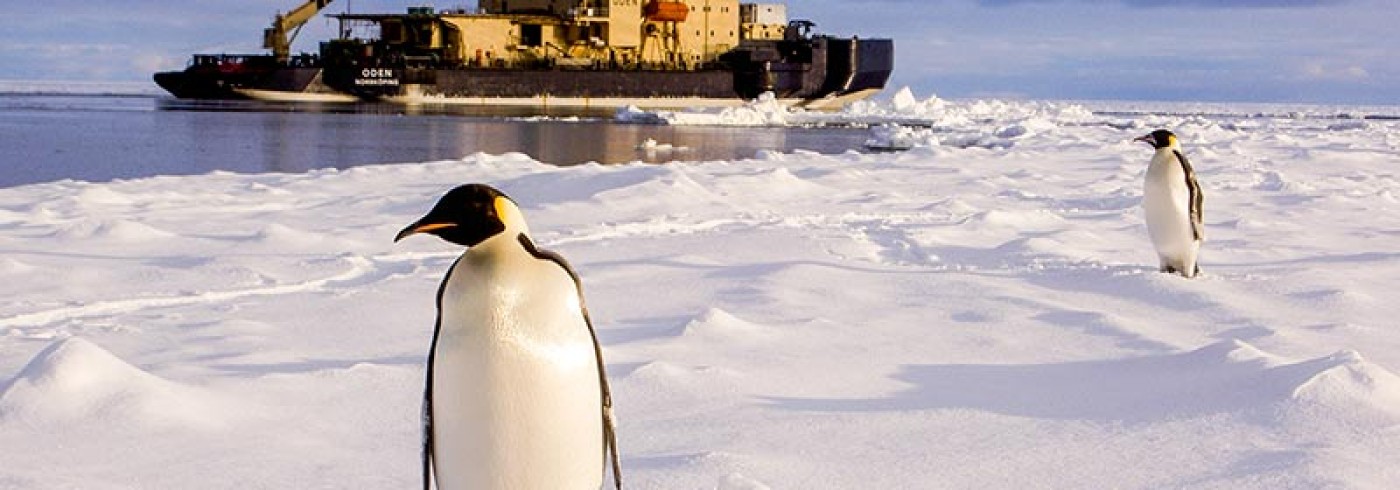Oden Southern Ocean - Swedish Science projects
29 November 2007 - 7 January 2008The main objective for the icebreaker Oden’s visit to the Southern Ocean was to open up a shipping lane for the supply ships to McMurdo Station run by the National Science Foundation (NSF). However, as Oden is well equipped for research and can operate in areas that are otherwise difficult to reach when the sea is ice covered, the cruise provided an excellent opportunity for several Swedish research groups to develop collaboration with American colleagues on research in Antarctica. In total 14 scientific projects were put into motion, of which half were Swedish.
Most of the research interest was directed to the polynia in the Amundsen Sea. Several vessels have studied the Amundsen Sea at a later point during the summer season, but very few have endeavoured the task during early spring due to the problems posed by the presence of heavy sea ice that has to be penetrated during any other season than summer.
Furthermore, research was also conducted in other areas en route. Sampling of surface water and air could be carried out under way, while deep water samples were taken during stops, when also ice, snow, brine (very saline water inside the ice) and plankton samples were taken. In addition, a couple of groups took the opportunity to take surface water and air samples during the journey from Sweden to Punta Arenas, Chile, in order to obtain data from both sides of the equator and thereby enable a better comparison between the northern and southern hemispheres than has previously been possible.
Science projects

In order to take samples it is sometimes necessary to dig deep in the snow sheet. Photo: Jakob Wegelius
Whale-fall ecology
The first stop made during the research section of the expedition was on the lee of the South Shetland Islands. Here ecologists from University of Gothenburg deployed “landers” with skeletal bones from minke whale to study how these are colonised by organisms; especially an organism called Osedax mucofloris (latin for bone-eating mucus f lower). This worm has no mouth or gut, but instead grows a system of root-like tubes into the bones of large dead whales and employ bacteria housed inside these roots to obtain energy from the oil-rich bone marrow.
Biogenic halocarbons and ozone-depletion
A group from Chalmers University of Technology in Gothenburg studied the natural production of various halocarbons. Halocarbons are small organic molecules that contain halogen atoms, many of which have been identified as ozone-depleting. The use of man-made halocarbons is essentially banned under the Montreal Protocol to protect the stratospheric ozone layer. However, molecules of this type are also produced by some algae, and an understanding of the natural production processes and how these may affect and be affected by climate change are important for the support of pertinent decision-making
Microbiology
Marine bacteria are key players in the recycling of most nutrients in marine waters and consequently directly or indirectly affect all organisms, from microscopic viruses to fish and the whales. Bacterial communities harbour a large diversity, species composition significantly affecting the ecological role of bacteria. Today we can study the bacterial communities using molecular biology and this was the research theme for a group of microbiologists from Kalmar and Uppsala Universities.
Environmental pollutants
A group from the Swedish University of Agricultural Sciences and the Virginia Institute of Marine Science studied the global fate of persistent organic pollutants (POPs) of which the most notorious are probably DDT and PCB. It is presumed that the Polar Regions are contaminated by a “global distillation” process, as the contaminants are less volatile in the cold regions than around the equator. Although substantial work has been carried out in the Arctic, very little has previously been conducted at low latitudes and in the southern hemisphere.
Carbon dioxide flux and climate change
To understand the effects of increasing carbon dioxide in the atmosphere two projects from University of Gothenburg made use of the journey on Oden to measure the carbon dioxide levels in the air and surface water and compare these with satellite images of phytoplankton activity (as chlorophyll) and sea water temperature. Because of the difficulties of sampling in the ice covered waters there is little information from direct measurements in surface waters that can be compared with satellite images.
Picoplankton
The smallest living organisms capable of independent self-replication are photosynthetic picoplankton. These measure just a few hundred nanometres in diameter and comprise a large part of the total carbon fixating organisms. Organisms of this size cannot be studied efficiently with traditional microscopic techniques. During the expedition a group from Uppsala and Stanford Universities took samples of water, air, snow etc. to isolate picoplankton. This project aims at developing methods to derive highresolution images of a small living cell across multiple levels of biological organisation.


